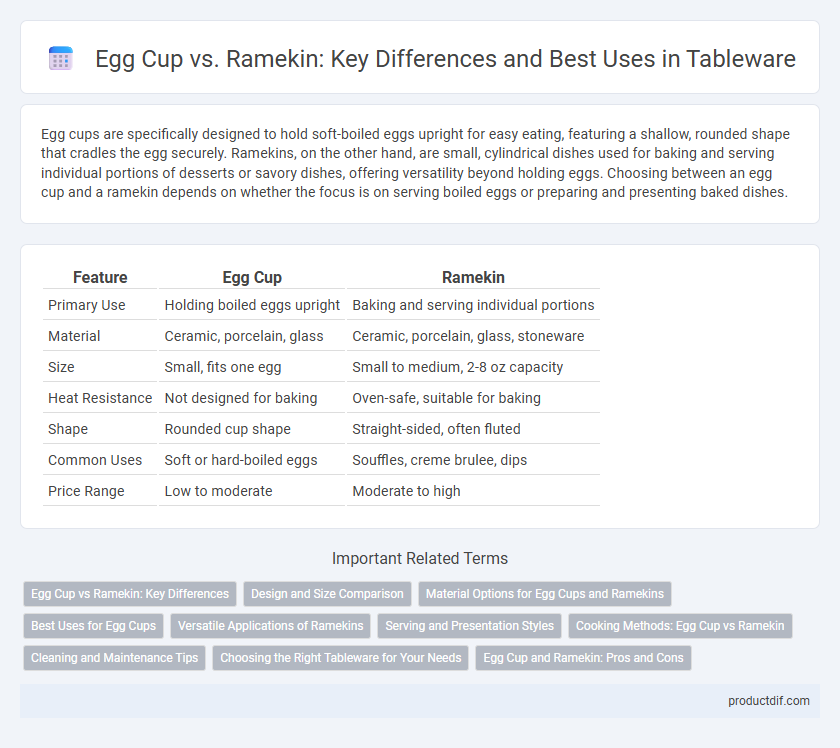Egg cups are specifically designed to hold soft-boiled eggs upright for easy eating, featuring a shallow, rounded shape that cradles the egg securely. Ramekins, on the other hand, are small, cylindrical dishes used for baking and serving individual portions of desserts or savory dishes, offering versatility beyond holding eggs. Choosing between an egg cup and a ramekin depends on whether the focus is on serving boiled eggs or preparing and presenting baked dishes.
Table of Comparison
| Feature | Egg Cup | Ramekin |
|---|---|---|
| Primary Use | Holding boiled eggs upright | Baking and serving individual portions |
| Material | Ceramic, porcelain, glass | Ceramic, porcelain, glass, stoneware |
| Size | Small, fits one egg | Small to medium, 2-8 oz capacity |
| Heat Resistance | Not designed for baking | Oven-safe, suitable for baking |
| Shape | Rounded cup shape | Straight-sided, often fluted |
| Common Uses | Soft or hard-boiled eggs | Souffles, creme brulee, dips |
| Price Range | Low to moderate | Moderate to high |
Egg Cup vs Ramekin: Key Differences
Egg cups are specifically designed to hold soft-boiled eggs upright, featuring a small, rounded cavity that fits the egg securely, while ramekins are versatile, straight-sided dishes used for baking and serving individual portions of custards, souffles, or dips. Egg cups typically have a smaller size and simpler design focused on functionality for egg consumption, whereas ramekins vary in size and material, often made from ceramic or glass to withstand oven temperatures. The key differences lie in their intended use, shape, size, and heat resistance, with egg cups tailored for breakfast presentation and ramekins designed for culinary preparation and serving.
Design and Size Comparison
Egg cups typically feature a compact, rounded design specifically tailored to hold a single boiled egg securely, measuring around 2 to 3 inches in height and diameter. Ramekins boast a cylindrical shape with taller, straight sides and a larger capacity, usually ranging from 3 to 4 inches in height and 3 to 5 inches in diameter, suitable for individual portions of baked dishes. The design of egg cups prioritizes stability and ease of egg consumption, while ramekins emphasize versatility and oven-proof functionality due to their thicker ceramic construction.
Material Options for Egg Cups and Ramekins
Egg cups primarily come in ceramic, porcelain, stainless steel, and plastic, each offering distinct durability and heat retention properties. Ramekins are commonly crafted from ceramic, porcelain, glass, or sometimes silicone, providing versatile resistance to oven temperatures. Ceramic and porcelain options in both egg cups and ramekins ensure easy cleaning and elegant presentation suitable for various table settings.
Best Uses for Egg Cups
Egg cups are specifically designed to hold soft-boiled eggs, making them ideal for serving eggs directly at the table while maintaining the perfect shape and temperature. Their compact size and shallow well provide stability and easy access for eating with a spoon, unlike ramekins which are primarily used for baking and serving desserts. Egg cups offer a specialized function in breakfast settings, enhancing both presentation and convenience for egg consumption.
Versatile Applications of Ramekins
Ramekins offer versatile applications beyond serving egg cups, including baking souffles, custards, and individual pot pies. Their oven-safe ceramic construction ensures even heat distribution for precise cooking and heating. Unlike egg cups, ramekins can seamlessly transition from preparation to serving, enhancing both kitchen functionality and table presentation.
Serving and Presentation Styles
Egg cups highlight the delicate presentation of soft-boiled eggs, elevating breakfast aesthetics with their petite, upright design. Ramekins serve versatile roles, from individual souffles to condiments, emphasizing a more substantial, oven-safe vessel for layered culinary creations. Both pieces enhance table settings but cater to distinct serving needs and visual impact in fine dining and casual meals.
Cooking Methods: Egg Cup vs Ramekin
Egg cups are primarily designed for serving soft-boiled eggs and are not suited for cooking, while ramekins are versatile baking dishes used for preparing custards, souffles, and individual casseroles. Ramekins can withstand high oven temperatures up to 500degF and are suitable for both microwave and conventional ovens, whereas egg cups are typically made from ceramic or porcelain and are not oven-safe. Choosing a ramekin over an egg cup expands cooking options, enabling slow baking and broiling techniques that cannot be performed with egg cups.
Cleaning and Maintenance Tips
Egg cups are typically smaller and easier to clean, often dishwasher-safe and made from ceramic or porcelain that resists staining. Ramekins, used for baking and serving, require thorough hand washing to remove baked-on food residues and often benefit from soaking to prevent stubborn stains. Both items should be dried completely to avoid moisture buildup that can lead to mold or unpleasant odors.
Choosing the Right Tableware for Your Needs
Choosing the right tableware depends on the intended use: an egg cup is specifically designed to hold soft or hard-boiled eggs upright for easy consumption, while a ramekin serves versatile purposes like baking, serving sauces, or holding individual portions of desserts. Consider durability and material--porcelain egg cups offer heat resistance and aesthetic appeal, whereas ceramic ramekins provide better heat distribution for oven use. Assess your dining habits and kitchen needs to select tableware that enhances functionality and presentation.
Egg Cup and Ramekin: Pros and Cons
Egg cups offer a compact design ideal for serving boiled eggs, providing stability and heat insulation, but they are limited to a single use and smaller portion size compared to ramekins. Ramekins excel in versatility, accommodating a variety of dishes from souffles to dips, with their oven-safe ceramic construction enabling even baking and presentation, though their larger size may not be practical for egg-specific serving. Choosing between egg cups and ramekins depends on the intended use, whether for focused egg presentation or broader culinary applications.
Egg Cup vs Ramekin Infographic

 productdif.com
productdif.com